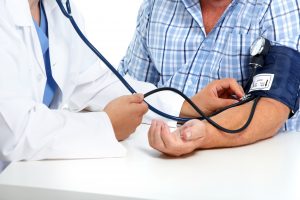 Blood pressure is determined by (1) the amount of blood the heart pumps and the amount of resistance to blood flow in the arteries. Consequently, the more blood the heart pumps, and the tighter the arteries, the higher the blood pressure.[1]
Blood pressure is determined by (1) the amount of blood the heart pumps and the amount of resistance to blood flow in the arteries. Consequently, the more blood the heart pumps, and the tighter the arteries, the higher the blood pressure.[1]
Chronic high blood pressure, or hypertension, can damage arterial walls and can eventually lead to an increased risk from heart disease, heart failure, other arterial diseases, kidney disease, irregular heart rhythms, osteoporosis, cognitive dysfunction, painful intercourse and stroke.[2] High blood pressure, also known as hypertension, is rampant in western societies. Untreated high blood pressure is a major killer. It is especially dangerous because it is primary risk factor for heart disease and stroke.
I have written several blogs on high blood pressure. Nevertheless, the experience of my friend Wayne may provide impetus for hypertension sufferers to try the sunshine solution.
Wayne, a resident of Texas, came to our former health resort seeking help for conditions of high blood pressure, obesity and various other maladies. I recommended, along with our healthful nutrition program, that he should sunbathe daily. Consequently, he “took it to heart” and could be found outside by the pool daily, dutifully soaking up the midday sunlight.
Wayne arrived at our program with a blood pressure of 157 systolic and 97 diastolic (157/97). Most noteworthy, those numbers put him at high risk for a stroke. Normal blood pressures are considered below 120 systolic, and below 80 diastolic. Four weeks later, as a result of his lifestyle changes. His numbers dropped to 125/54, meaning that he progressed from high stroke risk to very low stroke risk. Especially relevant is the fact that these changes were accomplished without medication.
The average drop in blood pressure among all guests at that program was 16 systolic and 12 diastolic. This is remarkable, considering that many of them had normal levels coming in.
Here are just a few of the blood pressure changes accomplished during that time:
- Frieda, from Oregon, lowered her blood pressure 33 points systolic and 30 points diastolic.
- Joyce, from Rhode Island, lowered her blood pressure 31 points systolic and 24 points diastolic.
- Jeff, from Utah, lowered his blood pressure 39 points systolic and 12 points diastolic.
- Susan, from New York, lowered her blood pressure 20 points systolic and 26 points diastolic.
Was all of this success due to sun exposure?
It should not be construed that these results were all a result of sun exposure. Nor should we conclude that hypertension is a result of sun deprivation. Typical American citizens engage daily in “killer” nutrition, subjecting themselves to dietary patterns and chemical additives that never existed in human life until modern times. Therein lie the major causes of hypertension. Hence, part of the improvements in blood pressure were due to the dietary changes we implemented with our guests.
More research regarding sunlight and blood pressure:
Sun exposure can, to an extent, act as an antidote to the poisons we consume. And, it acts much more quickly than dietary changes. Consider this: Dr. Oplander and his colleagues demonstrated that whole-body Ultraviolet A (UVA) irradiation worked what seemed like a miracle.[3] It caused a rapid, significant decrease of 11% in both systolic (upper number) and diastolic (lower number) blood pressure 30 minutes after the exposure. That change lasted up to 60 minutes. The lowered blood pressure lasted up to 60 minutes. Not only did blood pressure decrease, but arterial blood flow increased by 68%.
Nitric oxide, a potent vasodilator (blood-vessel relaxer) that occurs with sun exposure, was the photoproduct that led to these spectacular, important changes. This is important, because UVA is available almost any time the sun shines, winter and summer. Ultraviolet B (UVB) is not available in some areas during winter, due to the sun’s angle. This is especially true in the higher latitudes of the Northern hemisphere, or in the lower latitudes of the Southern hemisphere. UVB stimulates the production of vitamin D. So, it is especially relevant here that vitamin D was not involved in the lowering of blood pressure in Dr. Oplander’s study. Nitric oxide, however, was very involved.
Let’s take a look at one more study of sun exposure and hypertension: research China demonstrates that exposure to sun correlates to a lowered risk:[4] In a randomly selected population of Chinese residents from Macau (where the rate of hypertension is very high), the following risk factors for hypertension were assessed: lack of sun exposure, low intake of fish, smoking, obesity and lack of exercise. An average of more than one-half hour of sun exposure per day, as compared to no sun exposure, predicted a 40% reduced risk for hypertension.
I could go on for another page about the horrors of blood-pressure medication, but what I have said suffices. Non-burning sun exposure is one of the best elixirs for hypertension. In conclusion, one might say that it is no wonder that Wayne overcame his blood pressure problem!
[1] Mayo Clinic Diseases and Conditions: High blood pressure (hypertension). http://www.mayoclinic.org/diseases-conditions/high-blood-pressure/basics/definition/con-20019580 (accessed January 5, 2016).
[2] Ann Pietrangelo. Healthline 2014 http://www.healthline.com/health/high-blood-pressure-hypertension/effect-on-body (accessed January 4, 2016).
[3] Opländer C, Volkmar CM, Paunel-Görgülü A, van Faassen EE, Heiss C, Kelm M, Halmer D, Mürtz M, Pallua N, Suschek CV.. Whole body UVA irradiation lowers systemic blood pressure by release of nitric oxide from intracutaneous photolabile nitric oxide derivates. Circ Res. 2009;105:1031–40.
[4] Ke L, Ho J, Feng J, Mpofu E, Dibley MJ, Feng X, Van F, Leong S, Lau W, Lueng P, Kowk C, Li Y, Mason RS, Brock KE. Modifiable risk factors including sun exposure and fish consumption are associated with risk of hypertension in a large representative population from Macau. J Steroid Biochem Mol Biol 2013 Nov 1 [Epub ahead of print].
 UVB is a spectrum of sunlight with many effects. These include the suppression of inflammation in the skin. It has been used to very successfully treat skin diseases such as psoriasis and eczema.
UVB is a spectrum of sunlight with many effects. These include the suppression of inflammation in the skin. It has been used to very successfully treat skin diseases such as psoriasis and eczema.
Since inflammation is necessary to produce the condition of atherosclerosis (plugging of the arteries). It would be interesting to know whether UVB might also have the same anti-inflammatory effects in the arteries. If so, the effect could inhibit or eliminate atherosclerosis, and thus provide an entirely new treatment for heart disease. It would also protect against vascular events such as stroke and intermittent claudication.
The idea that UVB could prevent atherosclerosis by reducing inflammation in arteries was recently studied by Japanese researchers.[i] Using a mouse model, they demonstrated that UVB light irradiation, applied once a week for 14 weeks, leads to an increase in the action of T-regulatory cells, thereby inhibiting inflammation. In addition, exposure reduced the production of another type of T-cell which is pro-inflammatory and thereby pro-atherogenic (leading to the production of atherosclerosis). These two effects of UVB light reduce the development and progression of atherosclerosis.
Stated differently, the research shows that sun exposure is a critically-important therapy to reduce and prevent diseases of the heart and blood vessels. Protect your heart by being sure to obtain sufficient non-burning sunlight from sun exposure or other sources such as sun lamps. It is also important to note that neither skin cancer nor skin inflammation were observed following UVB exposure in this breakthrough study, which again emphasizes the importance of sun exposure for human health.
If these findings are true, then we would expect that there would be fewer cardiovascular events such as heart attacks and strokes during times of less sun exposure. Accordingly, Research has demonstrated that those below the median level of serum vitamin D suffer 57% more heart attacks than those whose levels were above the median[i] (low vitamin D levels are a surrogate for sun exposure). They also noted that the greatest number of heart attacks occurred in winter and early spring. These seasons, of course, are the times of lowest sun exposure. And, according to what we have learned, they are also the times of greatest inflammation.
Let there be light, and safely apply it to your skin. Be sure not to burn.
[i] Scragg R, Jackson R, Holdaway IM, Lim T, Beaglehole R. Myocardial infarction is inversely associated with plasma 25-hydroxyvitamin D3 levels: a community-based study. Int J Epidemiol 1990;19:559-63.
[i] Sasaki N, Yamashita T, Kasahara K, Fukunaga A, Yamaguchi T, et al. UVB Exposure Prevents Atherosclerosis by Regulating Immunoinflammatory Responses. Arterioscler Thromb Vasc Biol. 2016;36:00-00
The circadian rhythm is a variation in physiology and behavior persistent with a cycle length close to 24 hours, and regular sun exposure and dark exposure are is necessary to keep the cycle intact.[1] The circadian cycle in humans is approximately 24-hours in length and must be reset on a daily basis in order to remain in synchronization with the external environment. Sun exposure at the correct times of day is exceptionally important to human health, and when the cycle is disrupted by lack of light, such as that experienced by shift workers, or by those who live constantly indoors, it leads to a feeling of being “out of sync.” Disruption of the circadian rhythm may lead to increased breast-and/or-colorectal cancer risk in women,[2] [3] and research has demonstrated that disruption of circadian rhythms may lead to a profound increase in the risk of heart disease, metabolic syndrome, lung cancer[4] and other cancers.[5] [6]
According to the Journal Sleep Health, morning daylight exposure helps to reset the circadian rhythm or properly maintain it, which leads to better sleep at night.[7] The authors and researchers used a specialized device to measure the type of light that keeps the circadian rhythm of the human body properly set. By comparing workers in different buildings for sleep quality, they determined that those who received higher levels of morning light had considerably better sleep quality. They stated this conclusion: “The present study is the first to measure personal light exposures in office workers using a calibrated device that measures circadian-effective light and relate those light measures to mood, stress, and sleep. The study’s results underscore the importance of daytime light exposures for sleep health.” See also this link: http://sunlightinstitute.org/sleep-quality-is-improved-by-exposure-to-nature-and-sunlight/
Insomnia is a terrible problem in our modern life. To a great extent, that problem could be solved by arising early and taking advantage of an hour of morning sun exposure.
Safely enjoy your sun exposure, sleep tight and improve your health!
[1] Jeanne F. Duffy, M.B.A., Ph.D. and Charles A. Czeisler, Ph.D., M.D. Effect of Light on Human Circadian Physiology. Sleep Med Clin. 2009 Jun; 4(2): 165–177.
[2] Davis S, Mirick DK. Circadian disruption, shift work and the risk of cancer: a summary of the evidence and studies in Seattle. Cancer Causes Control 2006;17:539-45.
[3] Reparto di ChirurgiaGenerale A/D, PoliclinicoSant’Andrea, Sapienza Università di Roma. [Night work as a possible risk factor for breast cancer in nurses. Correlation between the onset of tumors and alterations in blood melatonin levels]. Prof Inferm. 2007;60:89-93
[4] Papagiannakopoulos T, Bauer MR, Davidson SM, Heimann M, Subbaraj L, Bhutkar A, Bartlebaugh J, Vander Heiden MG, Jacks T. Circadian Rhythm Disruption Promotes Lung Tumorigenesis. Cell Metab. 2016 Jul26;(16)30312-2016.07.001.
[5] Vignesh Shanmugam, Amro Wafi, Nawaf Al-Taweel and Dietrich Büsselberg. Disruptions of circadian rhythm
Increase the risk of cancer, metabolic syndrome and cardiovascular disease. Journal of Local and Global Health Science, 2013:3.
[6] Bratsun DA, Merkuriev DV, Zakharov AP, Pismen LM. Multiscale modeling of tumor growth induced by circadian rhythm disruption in epithelial tissue. J Biol Phys. 2015 Aug 21. [Epub ahead of print]
[7] Mariana G. Figueiro, Bryan Steverson, MA, Judith Heerwagen, PhD, Kevin Kampschroer, MA, Claudia M. Hunter, PhD, Kassandra Gonzales, MS, Barbara Plitnick, RN, Mark S. Rea, PhD. The impact of daytime light exposures on sleep and mood in office workers. Sleep Health June 2017;3:204-215.
Sun exposure reduces risk of heart disease. High cholesterol levels are associated with vascular diseases such as heart disease, ischemic stroke and intermittent claudication (an occlusion of the arteries of the legs that leads to pain and disability). The authors of a recent study compared the effects of vitamin D supplementation with sun exposure to determine which was more effective in reducing risk factors.[1] A group of individuals with insufficient serum vitamin D levels was divided into two groups with different experimental protocols: one was treated with sun exposure to the arms and face between 11 AM and 3 PM and the other was treated with 1,000 IU of vitamin D. A third group had “normal” vitamin D levels and served as a control (no treatment group). Total cholesterol levels and its components of cholesterol, HDL and LDL, were also measured to determine the positive (or negative) effects of the two treatment protocols.
The results were enlightening. Both experimental groups had significant increases in vitamin D. However, the results with cholesterol varied. A significant decrease in total cholesterol was noted in the sun exposure group, and HDL and LDL also decreased in the sun-exposure group. However, in the vitamin D-supplement group, a significant increase was noted in in total cholesterol. HDL also increased significantly, and LDL increased non-significantly.
In other words, vitamin D supplementation could actually lead to an increased risk of vascular diseases by raising total cholesterol, whereas sun exposure is protective against those diseases. So the takeaway is that there is no substitute for the sun when it comes to providing some protection against vascular diseases.
There are those people who worry that melanoma risk may be increased by regular sun exposure. However, we have mentioned many time in this blog that melanoma is much more common among those who work indoors than those who work outdoors. It should also be mentioned that vascular diseases kill far more people than skin cancer. Dr. Richard perhaps said it best:
“Sunlight may have beneficial cardiovascular effects, independently of Vitamin D production. Vitamin D could, in these circumstances, act as a marker for sunlight exposure and its postulated beneficial effects. These recent human data show the physiological relevance of photorelaxation. High blood pressure is the leading cause of disability-adjusted life years lost worldwide and as a risk factor underlies 18% of all deaths.” Weller further noted: “The action spectrum of nitrite release shows ultraviolet B is also involved in nitrite reduction to Nitric Oxide, and thus sunlight may be more effective than a pure UVA source.” He concluded: “the prevalence of cardiovascular and cerebrovascular deaths is around 100 times higher than those from skin cancer. Interventions leading to small changes in the incidence of cardiovascular disease are thus of greater benefit to the health of the public even than large changes in skin cancer incidence.”[2]
Safely embrace the sun and your heart, brain and blood vessels will love you for it!
[1] Patwardhan VG, Mughal ZM, Padidela R, Chiplonkar SA, Khadilkar VV, Khadilkar AV. Randomized Control Trial Assessing Impact of Increased Sunlight Exposure versus Vitamin D Supplementation on Lipid Profile in Indian Vitamin D Deficient Men. Indian J Endocrinol Metab. 2017 May-Jun;21(3):393-398.
[2] Weller R. The health benefits of UV radiation exposure through vitamin D production or non-vitamin D
Pathways. Blood pressure and cardiovascular disease. Photochem. Photobiol. Sci. 2016.
Sun Exposure and health by Marc Sorenson, EdD…
A very interesting study has been completed in a remote area of South America.
An indigenous tribe from the remote Bolivian Amazon jungle, known as the Tsimane, has been found to have the world’s healthiest arteries.[1] People there survive on a diet low in saturated fats and high in non-processed foods. One of the researchers stated that “Our study shows that the Tsimane indigenous South Americans have the lowest prevalence of coronary atherosclerosis of any population yet studied.”
Here are some of the lifestyle habits and facts regarding the Tsimane.
- The diet is fiber rich.
- The diet is approximately 75% non-processed carbohydrates. Isn’t that supposed to make us fat?
- The diet includes rice, plantain (a type of banana), corn, nuts, and a very small amount of animal meat.
- Smoking is almost non-existent.
- Only three per cent of the people had moderate to high heart disease risk; two-thirds of them over 75 years of age had virtually no risk. The article states that only 14% of Americans had no risk, and that half had a moderate or high risk—about 5 times higher than the Tsimane.
- Men spend six to seven hours of their day being physically active, whereas women spend four to six hours. This, of course, means plenty of sun exposure.
During most of my professional career, I have advised people to live on this type of diet, but without the meat or any other animal product. In addition we helped them to exercise several hours daily outside. During that time, my wife and I have observed that people have recovered from diabetes, heart disease, arthritis and other maladies. That is no surprise, considering this new research and many other studies. Vitamin D and nitric oxide, both photoproducts, are exceptionally important to human health, but when it comes to heart disease, nitric oxide is probably the operative photoproduct. Here is a quote from Dr. Richard Weller, a common-sense dermatologist and great researcher:
“Sunlight may have beneficial cardiovascular effects, independently of Vitamin D production. Vitamin D could in these circumstances act as a marker for sunlight exposure and its postulated beneficial effects.” “These recent human data show the physiological relevance of photorelaxation. High blood pressure is the leading cause of disability adjusted life years lost worldwide and as a risk factor underlies 18% of all deaths.” The study noted: “The action spectrum of nitrite release shows that ultraviolet B is also involved in nitrite reduction to Nitric Oxide, and thus sunlight may be more effective than a pure UVA source.” The study concluded: “the prevalence of cardiovascular and cerebrovascular deaths is around 100 times higher than those from skin cancer. Interventions leading to small changes in the incidence of cardiovascular disease are thus of greater benefit to the health of the public even than large changes in skin cancer incidence.”[2]
The Tsimane, therefore, are living (unknowingly) an almost perfect lifestyle for optimal health. To stay well, it is imperative that we do the same, although we don’t need quite that much sun exposure. Remember to build up a tan and be safe in the sun.
[1] http://www.mirror.co.uk/science/proof-modern-life-really-kill-10047382
[2] Weller R. The health benefits of UV radiation exposure through vitamin D production or non-vitamin D pathways. Blood pressure and cardiovascular disease. Photochem. Photobiol. Sci. 2016, DOI: 10.1039/C6PP00336B.
UVB exposure benefits by Marc Sorenson, EdD. Sunlight Institute…
UVB is a spectrum of sunlight that is responsible for stimulation of vitamin D production in the skin. It also has many other effects, including the suppression of inflammation in the skin, and thus has been used to very successfully treat skin diseases such as psoriasis and eczema.[1] [2] [3] [4]
Since inflammation is also necessary to produce the condition of atherosclerosis (arterial plugging or occlusion) in arteries, it would be interesting to know whether UVB light might also have the same anti-inflammatory effects in those arteries. If so, the UVB effect could inhibit or eliminate atherosclerosis, and by so doing provide an entirely new treatment for heart disease and other vascular events such as stroke and intermittent claudication.
The idea that UVB could prevent atherosclerosis by reducing inflammation in arteries was recently studied by Japanese researchers.[5] [6] Using a mouse model, they demonstrated that UVB light irradiation, once weekly for 14 weeks, leads to an increase in the action of T-regulatory cells that inhibit inflammation. In addition, UVB exposure also reduced the production of another type of T-cell that is pro-inflammatory, and thereby proatherogenic (leading to the production of atherosclerosis). These two effects of UVB light reduce the development and progression of atherosclerosis. Or stated differently, the research shows that sun exposure is critically-important therapy to reduce and prevent heart and other vascular diseases.
Protect your heart by being sure to obtain sufficient non-burning UVB light from sun exposure or other sources such as the UVB lamps used by the researchers. It is important to note that neither skin cancer nor skin inflammation were observed following UVB exposure.
This is another breakthrough study that emphasizes the necessity of sun exposure for human health.
[1] National Psoriasis Foundation web site Oct. 2005.
[2] Yelverton CB, Kulkarni AS, Balkrishnan R, Feldman SR. Home ultraviolet B phototherapy: a cost-effective option for severe psoriasis. Manag Care Interface 2006;19:33-36, 39.
[3] Situm M, Bulat V, Majcen K, Dzapo A, Jezovita J. Benefits of controlled ultraviolet radiation in the treatment of dermatological diseases. Coll Antropol. 2014 Dec;38(4):1249-53.
[4] Gupta A, Arora TC, Jindal A, Bhadoria AS. Efficacy of narrowband ultraviolet B phototherapy and levels of serum vitamin D3 in psoriasis: A prospective study. Indian Dermatol Online J. 2016 Mar-Apr;7(2):87-92.
[5] Naoto Sasaki, Tomoya Yamashita, Kazuyuki Kasahara, Atsushi Fukunaga, Tomoyuki Yamaguchi, et al. UVB Exposure Prevents Atherosclerosis by Regulating Immunoinflammatory Responses. Arterioscler Thromb Vasc Biol. 2016;36:00-00.
DOI: 10.1161/ATVBAHA.116.308063.)
[6] Hafid Ait-Oufella, Andrew P. Sage. Editorial. The Sunlight. A New Immunomodulatory Approach of Atherosclerosis. (Arterioscler Thromb Vasc Biol. 2017;37:7-9. DOI: 10.1161/ATVBAHA.116.308637.)
By Marc Sorenson, EdD. Sunlight Institute…
In end stage kidney disease, heart disease and other vascular diseases are often the most dreadful accompanying disorders, also known as a comorbidities. Any healthful procedure that can mitigate the distress of these diseases can be a godsend to the patient suffering from kidney deterioration. UV therapy, similar to sun exposure, has now been shown to alleviate some of the difficulties of cardiovascular diseases and thereby increase the quality of life.[1]
The research was conducted on fourteen kidney-dialysis patients. They were irradiated with whole-body UV for six months. Before and after that time, they were measured for several physiological functions to determine if there had been worthwhile changes in indicators of cardiovascular diseases. These were the results:
- Hematocrit increased, indicating a larger volume of red blood cells, which are important for carrying oxygen to the heart, vessels and all other parts of the body.
- The patients required less erythropoietin, a hormone that stimulates production of red blood cells and hemoglobin in case of low-tissue oxygen. This would indicate that oxygen need was reduced after the UV treatment, putting less stress on the cardiovascular system.
- In addition to, or perhaps because of, these positive changes, maximal oxygen uptake increased, indicating greater work capacity and physical fitness.
- Workload capacity increased and lactic acid production decreased, also indicative of enhanced physical fitness.
- Pulse rate decreased, indicative of an ability of the heart to deliver more oxygen per beat through the cardiovascular system. This is also a fitness measurement.
- Both systolic and diastolic blood pressures decreased, showing a healthier vascular system.
The researchers made the following conclusion: “Cardiovascular disease is the most important comorbidity [to kidney disease]. Exposure to simulated sunlight that contains both UVB and UVA reduce cardiovascular risk factors and improve quality of life.”
Protect your kidneys or protect your heart either by safe exposure to the “simulated sunlight” of sunlamps or tanning devices, or by regularly exposing yourself (again, safely) to mankind’s best friend the Sun.
[1] Krause R, Stange R, Kaase H, Holick MF. UV Irradiation and Pleiotropic Effects of Vitamin D in Chronic Kidney Disease – Benefits on Cardiovascular Comorbidities and Quality of Life. Anticancer Res. 2016 Mar;36(3):1403-8.
Marc Sorenson, EdD, Sunlight Institute.
Anything that causes arterial plugging or prevents the relaxation of blood vessels can contribute to cardiovascular diseases (CVD). Poor diet, little exercise and lack of sunlight exposure form a combination that devastates vessel health and reduces the flexibility of those vessels. Among the CVD are ischemic heart disease, intermittent claudication (painful oxygen restriction to the legs), ischemia of the brain leading to strokes, peripheral artery disease and erectile dysfunction. Yes, I said erectile dysfunction.
ED is considered one of the major predictors of CVD.[i] It is caused by inability of the corpus cavernosa, two cylindrical chambers that run the length of the penis, to become engorged with blood, causing erection. When the process takes place normally, the cavernosa are stimulated by nitric oxide (NO), they then relax, and blood flows into the penis, allowing erection to take place. Therefore, erection is a vascular event.[ii] The same effect is seen in blood pressure decreases caused by NO after sunlight exposure. Ultraviolet A (UVA) light stimulation of the skin causes the release of NO from pre-formed stores of NO in the skin. NO is a potent vasodilator, and when it is released into the arteries by UVA stimulation, causes increased blood flow and lowers blood pressure.[iii] The mechanism is much the same in both instances. This is another example of sunlight enhancing health without the benefit of vitamin D. UVA light, that stimulates nitric oxide release, does not stimulate the skin to produce vitamin D.
An early study assessed the affect of ultraviolet light (UV) exposure to cavernosal strips, which were obtained from men during penile prosthetic surgery.[iv] The strips showed relaxation in response to UV, and the relaxation increased with the duration of exposure. We expect that sunbathing, which would profoundly increase NO in the circulation, would also vasodilate the cavernosa to allow erection. The same nitric oxide mechanism that lowers blood pressure, would seem to be a good method to treat ED. After all, drugs for ED, such as Viagra and Cialis, work by enhancing the effects of nitric oxide.[v] Sunlight is free and is a much better choice.
[i] Pastuszak AW, Hyman DA, Yadav N, Godoy G, Lipshultz LI, Araujo AB, Khera M. Erectile dysfunction as a marker for cardiovascular disease diagnosis and intervention: a cost analysis. J Sex Med 2015 Apr;12(4):975-84.
[ii] Marc Sorenson and William B. Grant. Does vitamin D deficiency contribute to erectile dysfunction? Dermatoendocrinol 2012 Apr 1; 4(2): 128–136.
[iii] Liu D, Fernandez BO, Hamilton A, Lang NN, Gallagher JM, Newby DE, Feelisch M, Weller RB. UVA irradiation of human skin vasodilates arterial vasculature and lowers blood pressure independently of nitric oxide synthase. J Invest Dermatol. 2014 Jul;134(7):1839-46.
[iv] Kim SC, Oh CH, Park JK, Lee MY, Uhm DY. Effects of ultraviolet light on the tension of isolated human cavernosal smooth muscle from non-diabetic and diabetic impotent men. Urol Res. 1997;25(2):149-52.
[v] Mayo Clinic Online. http://www.mayoclinic.org/diseases-conditions/erectile-dysfunction/in-depth/erectile-dysfunction/art-20047821. Accessed July 3, 2015.
